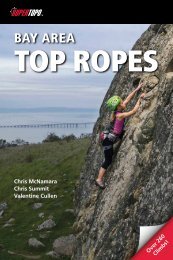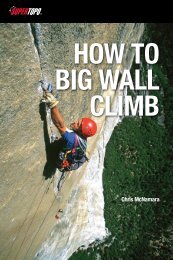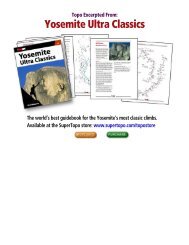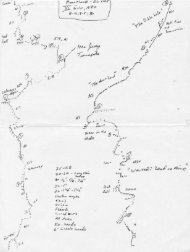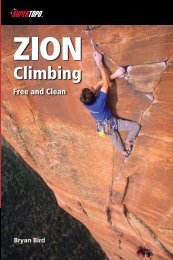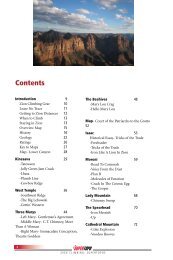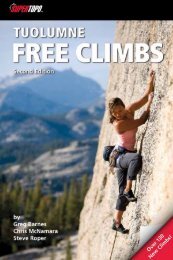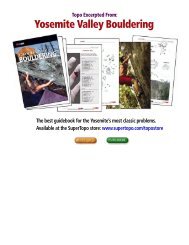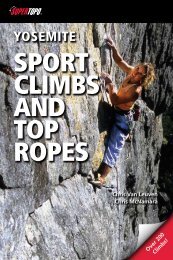The Definitive Guide To Yosemite Big Wall Climbing - SuperTopo
The Definitive Guide To Yosemite Big Wall Climbing - SuperTopo
The Definitive Guide To Yosemite Big Wall Climbing - SuperTopo
Create successful ePaper yourself
Turn your PDF publications into a flip-book with our unique Google optimized e-Paper software.
Food Storage<br />
Do not leave any food, drinks, toiletries, or<br />
trash at the base of the wall–bears deliberately<br />
seek food there because of climber trash and<br />
food caches. While preparing for a wall you<br />
must store food and all scented items in bearresistant<br />
canisters or hang it at least 50 feet off<br />
the ground on 5.10 or harder climbing. Think<br />
that’s overkill? I’ve seen bears climb 5.10 slab<br />
below Mescalito, 5.9 crack 50 feet up the first<br />
pitch of the Regular North West Face of Half<br />
Dome, and paw up 5.6 hand jams two pitches<br />
up After Six. <strong>The</strong>y weren’t climbing for fun<br />
or adventure–they were risking their lives for<br />
Clif Bars and King Cobras. In short, if you can<br />
reach your food without climbing gear (even<br />
free-soloing), it is not<br />
stored correctly.<br />
Remember to<br />
remove all food,<br />
scented items, and<br />
even empty wrappers<br />
from your car. Bears<br />
are attracted to a<br />
mess–wrappers, beer<br />
cans, and general<br />
disarray may provoke<br />
a bear to break in<br />
to your vehicle to<br />
investigate. Bear-proof<br />
lockers are available at El Capitan Bridge, at<br />
the Zodiac parking area (Devil’s Elbow), <strong>The</strong><br />
Ahwahnee Hotel, and Bridalveil Fall, etc. (See<br />
map.) Please do not place a lock on these<br />
shared lockers.<br />
Peregrine Falcons<br />
Peregrine Falcon. Photo courtesy NPS<br />
During the FA of Sea of Dreams in 1978,<br />
Jim Bridwell, Dave Diegelman, and Dale Bard<br />
discovered a nesting pair of Peregrine Falcons–<br />
the first confirmed nest in the Park in 36 years<br />
and the beginning of a remarkable recovery<br />
by this bird. Climbers have helped wildlife<br />
biologists consistently since then to ensure the<br />
species survives.<br />
In 2009, 12 pairs were monitored in<br />
<strong>Yosemite</strong>, and they fledged 21 young. In 2010,<br />
for the first time since 1994, Peregrines nested<br />
on El Capitan; the nest site (aerie), on the<br />
North America <strong>Wall</strong>, was last occupied in 1986.<br />
<strong>To</strong> maximize reproductive success, the NPS<br />
may close areas to climbing during the nesting<br />
season, typically March 1st through August<br />
1st. In 2010 the El Capitan closure included<br />
all routes between and including “South Seas/<br />
Pacific Ocean <strong>Wall</strong>”, “North America <strong>Wall</strong>,” east<br />
to “Native Son”. Routes four pitches or fewer, at<br />
the base of the Southeast Face, remained open.<br />
Climbers can expect similar closures wherever<br />
Peregrines choose to nest in future years.<br />
Take Care of the Places You Love<br />
Most of you reading this probably already<br />
follow these low-impact climbing principles,<br />
and we thank you for leaving no trace. But<br />
you’ve probably seen junk on <strong>The</strong> Nose, at the<br />
base of the Regular North West Face, or at the<br />
summit of El Cap.<br />
Please help the park by<br />
educating your friends,<br />
by picking up trash,<br />
and by volunteering<br />
in community<br />
functions like the<br />
<strong>Yosemite</strong> Facelift<br />
(yosemiteclimbing.<br />
org).<br />
Unfortunately, the<br />
“easy” or entry-level<br />
routes are the most<br />
abused. This is what the uninitiated climber<br />
sees first, and hopefully he or she doesn’t take<br />
this poor example as the norm. In 1976 Chris<br />
Jones wrote in <strong>Climbing</strong> in North America,<br />
“Whatever reason the unsuccessful climbers<br />
gave, and they ranged from equipment failure<br />
to vitamin overdoses, the crux of the matter<br />
was people were still scared of big walls.” This<br />
is still true today, and if you are scared and<br />
struggling on a big wall the last thing you care<br />
about is your environmental impact. Please be<br />
patient–gain the skill to climb safely and with<br />
low impacts. It’s not just getting to the top that<br />
matters, it’s the trail you leave behind.<br />
*Regulations may change and the park<br />
user is expected to be up to date. For the latest<br />
information check nps.gov/yose/planyourvisit/<br />
climbing, supertopo.com/climbing/forum.php<br />
the Camp 4 kiosk, any Wilderness Center or the<br />
Mountain Shop.<br />
FOR CURRENT ROUTE INFORMATION, VISIT SUPERTOPO.COM<br />
CLIMBER IMPACTS<br />
21




